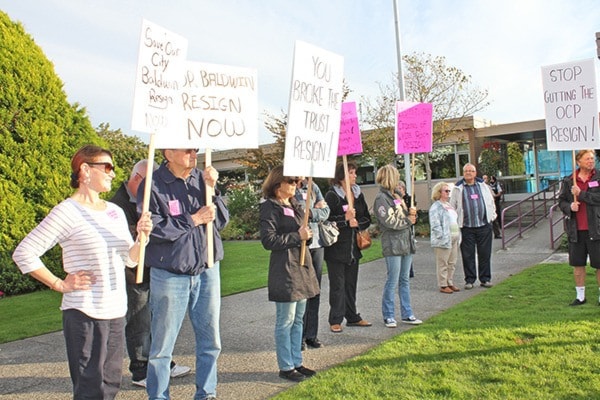It was an evening full of surprises, outbursts and calls for the mayor’s resignation at White Rock city council Monday, as the Metro Vancouver Regional Growth Strategy (RGS) took centre stage before an overflow crowd at council chambers.
One of the biggest revelations, that appeared to take many on council by surprise, was Metro’s proposed amendments – outlined at meetings in July – to the population projections laid out in the RGS, which would cut White Rock’s intake in half from 7,000 to 3,500 new residents by 2041.
The issue of the RGS has been much-debated in the community in recent weeks, since Mayor Wayne Baldwin wrote a public letter to Peace Arch News stating the city was “required by provincial law” to follow the RGS and “take its share of the forecast growth within the region.”
The amendments – as well as how the RGS aligns with the city’s Official Community Plan, currently under review – were discussed at length by Allan Neilson, Metro Vancouver’s general manager of planning, policy and environment.
Neilson described the RGS as a “high-level vision piece” that identifies how the region will accommodate growth over the next 25 years.
Neilson explained that while the Local Government Act requires a community’s OCP to be in line with the RGS – by way of a Regional Context Statement (RCS) submitted by a municipality and approved by Metro Vancouver – the projections outlined are not legally required to be upheld.
“The RCS that includes the projections is very clearly a commitment by every  municipality to plan its community in a way to put in place local planning policies that allow for the growth that is projected,” he said. “It’s something that we view as very important and we take very seriously.”
municipality to plan its community in a way to put in place local planning policies that allow for the growth that is projected,” he said. “It’s something that we view as very important and we take very seriously.”
Baldwin’s letter to PAN was one issue that prompted more than 90 residents to rally on the lawn of city hall prior to Monday’s meeting, calling on the mayor to resign.
Holding signs that read “You broke the public trust” and “Save our city,” residents later flocked to council chambers, spilling out into the hallway, as an RCMP officer looked on.
Later in the evening, Baldwin addressed his letter that has been criticized by many residents, and at least one councillor, as incorrect, standing firm in his assertion.
“I have a legal opinion on the letter that I gave, and the legal opinion is that it was quite correct,” he said. “It was a little too succinct, perhaps. The lawyer said that he would have done it with two pages, but that probably wouldn’t have been published.”
In discussing the reduced population numbers for White Rock, Neilson – along with Metro Vancouver’s director of regional planning, Elisa Campbell – told council that White Rock had submitted its revised RCS (which included population projections of 23,500 by 2041) to Metro in 2013, and it was subsequently approved by the region.
The amendments to the RGS that are now being tabled reflect those figures, he said.
“The change was initiated by the City of White Rock when it submitted its Regional Context Statement. We assessed that and said that seems reasonable in 2013 when the board accepted it,” Neilson said. “The amendment we’re putting in now will formally incorporate that into the RGS.”
In thanking Metro representatives for taking the time to speak on what he called a “hot topic,” Baldwin angered many in the gallery by noting there was “a lot of lack of knowledge on the part of the public, because it’s something that’s very complicated.”
Several in the crowd shouted out in response to Baldwin’s remark, calling for the mayor to “respect your citizens.”
After a brief recess, when much of the crowd angrily left chambers, director of planning Karen Cooper told council that staff was unaware of the new population projection figures, but noted they did appear on the agenda of a regional planning advisory committee meeting in July.
“I did not pick up that the population projection was being changed,” Cooper said. “It was when I read it after it was delivered to us in the middle of August that I noticed the change on the last, or second to last line.”
Coun. Lynne Sinclair – who later traded jabs with Coun. Helen Fathers about attending recent public-information meetings on proposed developments— expressed confusion about the change being made now, four years after the city requested lower projection numbers.
“I don’t understand why in 2015 we’re now doing what council of the day in 2009 thought was appropriate,” she said. “We knew the number was high, we told them that.”
Baldwin acknowledged that the proposed amendments also appeared on a “thousand-page agenda” at a Metro board meeting he attended in July, but again, went unnoticed.
“We had absolutely no idea that was coming, and that’s just not right,” he said of the reduced projections.
Prior to calling a vote to support the proposed amendments to the RGS, Baldwin addressed the controversy surround proposed developments outside the city’s town centre.
“All these developments that have caused everybody sleepless nights and thousands, literally, of emails have not yet come to council,” he said.
“Council has made absolutely no decisions – none, whatsoever – about any of these developments. So the thought that everybody is taking money under the table and all those things are completely erroneous. There are no decisions yet.”
